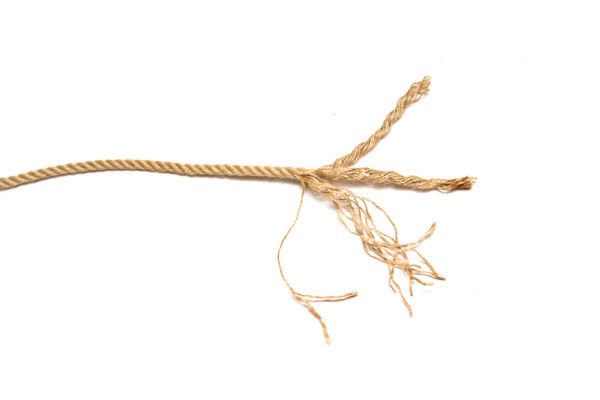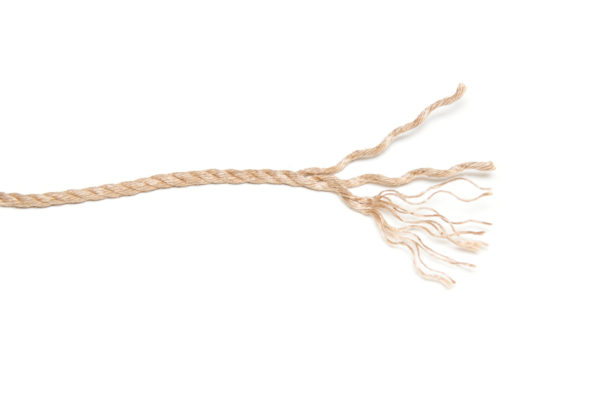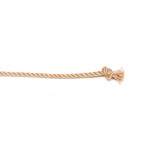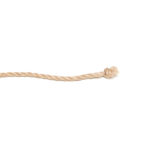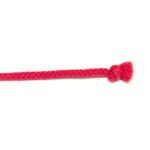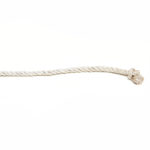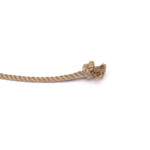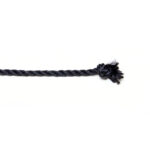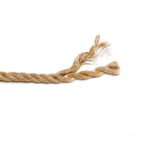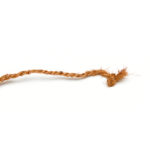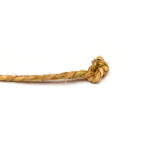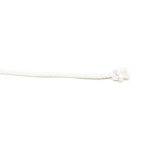In this post we’ll see the characteristics of some kinds of rope used in bondage – Western or Japanese – from the most common to the most unusual.
When I started doing bondage several years ago, I started using hemp ropes, but I soon moved to jute ropes that I found immediately smoother. But the turning point was when I started using Japanese jute ropes: they are light, soft and smooth. The ropes I use are “loose lay” (with a light torsion of the strands) so they are perfect to create ties that perfectly fit the body of the bottom and very compact knots and frictions.
I never use synthetic ropes. They aren’t suitable for my style (Japanese bondage) and they are too “plasticky” to the touch for my taste. However, they are widely used in Western bondage and they are useful for water bondage.
Choose the best rope for your ties according to your taste and style and always use high-quality products. Your bottoms will be grateful!
How is a rope made?
A rope is made by some strands twisted together.
Bondage ropes are usually made by three strands. Each strand is made by some plies, or a couple of yarns twisted together (in this case the rope is called “double ply”), or directly by single yarns (so we’ll have a “single ply” rope).
The twist of the rope can be more or less tight. A rope with a more relaxed twist is called “loose lay”. This kind of rope is softer and it fits perfectly knots and frictions.
Some ropes can have a core, a twine inside. They aren’t suitable for bondage because they tend to be too stiff.
In the first photo we can see a three strands double ply rope: one of the strands is frayed to show the plyes which are composed in turn by a couple of yarns twisted together.
In the second photo there is a three strands single ply rope. You can see a strand frayed and composed by some single yarns twisted together.
Ropes can be divided into twisted ropes (like the ones in the photos), where the strands are twisted together, and braided ropes, where strands are braided in order to create a sort of tube-shaped rope.
Let’s see some materials used for bondage ropes. Keep in mind that in natural fiber ropes the quality of the same material can change according to different species. For example European jute ropes are very different in material from Japanese ones.
JUTE ROPES
European jute ropes (Tossa rope)
Tossa jute ropes are smooth and light, but you have to boil or wash them before the use in order to give them the right softness. The majority of the ropes on the market are double ply and generally they have a quite tight twist, so they tend to be a little stiff. Tossa ropes are good for every kind of bondage.
Japanese jute ropes (asanawa)
“Asanawa” indistinctly indicates jute, hemp or linen fiber rope. Jute ropes are the most used in shibari. Japanese ropes are made of a different species of jute than the one used for European ropes and they have a more golden colour. They are often single ply and loose lay. These features make asanawa very soft, flexible and perfect for Japanese style bondage. Pay attention that on the market you can find some ropes called “asanawa” that imitate Japanese rope features but that are made in the West.
OTHER NATURAL FIBER ROPES
Cotton ropes
Cotton ropes are very soft and gentle on the skin. They aren’t strong so they aren’t suitable for suspensions. Moreover this kind of rope is elastic so it’s difficult to set the right tension. It’s also cheap, ready to use and easily washable. Cotton ropes are a good rope for simple ties or for “bedroom bondage”.
Hemp ropes
Hemp ropes are gentle on the skin but they aren’t as soft as cotton rope. They have a great load capacity, but they tend to be too compact and not smooth. In comparison with jute ropes, hemp ropes can be washed a few times without weakening. They have a typical smell of freshly cut grass.
SYNTHETIC FIBER ROPES
Polypropylene ropes
Synthetic ropes are in general strong and with bright colours. They are used in Western bondage, but they are not suitable for Japanese bondage because their smooth surface hasn’t the right grip for frictions and passages used in shibari. Synthetic ropes can be used for water bondage. Moreover they can create “burns” if they slide too quickly on the skin. Hempex is a kind of synthetic rope that imitates hemp rope but with plastic fibers. Polypropylene ropes are useful to hang rings or other suspension points.
ENFORCED ROPES
Enforced ropes
This is a natural fiber rope enforced with some yarns of polypropylene. As other synthetic ropes, enforced ropes can be used to hang rings or other suspension points. A strand of the rope in the photo was opened to show the different yarns twisted together.
OTHER MATERIALS
Coconut ropes (shuronawa)
This rope is made of palm fibers (and not by coconut or coconut palm, despite its name). It’s a very rough rope that gives interesting sensations on the skin.
Rice straw ropes (aranawa)
This rope is traditionally used in agriculture in Japan. Itoh Seiu did some famous shoot with model tied with this rope.
Other kinds of ropes
If you have a fetish for exotic ropes, in the market you can find very unusual ropes, like ropes made of alpaca, Manila, mohair, cachemire, ropes for electroplay or UV reactive ropes. The rope in the photo is a bamboo rope, a very smooth rope, with a pearlescent appearance, strong and flexible.
